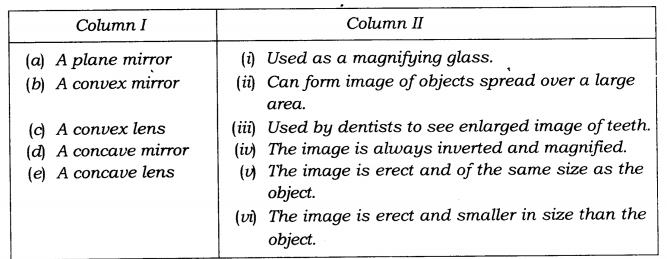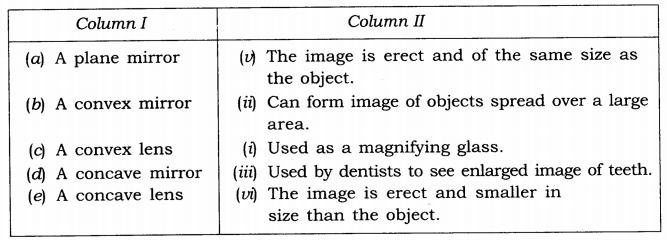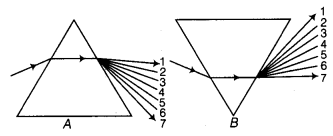CBSE CLASS 10 BOARD 2024 ALL IMPORTANT QUESTIONS

class6,class7,class8,class9,class10,class11,class12,government jobs news,cbse update news,jobs,competition exams,india news,news update,tech news,health news,mcq questions,question answer in hindi ,question answer in english,short answer type questions,very short answer type questions,product reviews,current affairs update news ,travel blog ,education news ,govt vacancy,competition exams notification,saraswati tuition centre,exam notes,maths concept,reasoning ,exam syllabus,ncert ,practice paper



Q.5.Find out the letters of English alphabet or any other language known to you in which the image formed in a plane mirror appears exactly like the letter itself. Discuss your findings.
Ans. Letters like A, H, I, M, O, T, U ,V, W etc. appear same when seen through a plane mirror
Q.6.What is a virtual image? Give one situation where a virtual image is formed.
Ans. The image which cannot be taken on a screen is called virtual image. When some object is placed very close to the concave mirror we don’t get any image on the white screen placed behind the mirror. Such image is called virtual image.
Q.7. State two differences between a convex and a concave lens.
Q.8. Give one use each of a concave and a convex mirror.
Ans. Use of concave mirror:
Concave mirror is used by dentists to examine the teeth.
Use of convex mirror:
Convex mirror is used as side view mirror in vehicles
Q.9. Which type of mirror can form a real image?
Ans. Concave mirror can form a real image.
Q.10. Which type of lens forms always a virtual image?
Ans. Concave lens always forms a virtual image.
Choose the correct option in Questions 11-13:
Q.11. A virtual image larger than the object can be produced by a
(i) concave lens (ii) concave mirror (iii) convex mirror (iv) plane mirror
Ans. (ii) concave mirror
Q.12. David is observing his image in a plane mirror. Die distance between the mirror and his image is 4 m. If he moves 1 m towards the mirror, then the distance between David and his image will be
(i) 3 m (ii) 5 m (iii) 6 m (iv) 8 m
Ans. (iii) 6 m
Q.13. The rear view mirror of a car is a plane mirror. A driver is reversing his car at a speed of 2 m/s. The driver sees in his rear mew mirror the image of a truck parked behind his car. The speed at which the image of the truck appears to approach the driver will be
(i) 1 m/s (ii) 2 m/s (iii) 4 m/s {iv) 8 m/s
Ans. (ii) 4 m/s
VERY SHORT QUESTION ANSWER..........
Question 1.
What type of mirror is used as a side view mirror in a scooter?
Answer:
Convex mirror.
Question 2.
How can we change the direction of the light?
Answer:
We can change the direction of the light by phenomenon called reflection
Question 3.
What happens when a beam of light enters a prism?
Answer:
The beam of light splits into seven colours.
Question 4.
Define briefly a convex mirror.
Answer:
A mirror which reflects the light from its inner polished side is a convex mirror.
Question 5.
When we see an ambulance we see that the letters which actually appears to right is seen by us on left side. What is this effect called?
Answer:
This effect is called lateral inversion.
Question 6.
What is virtual image?
Answer:
The image which cannot be obtained on a screen is called a virtual image.
Question 7.
What is a lens?
Answer:
A lens is a piece of refracting transparent medium bounded by two surfaces in which at least one has curved surface Concave and Convex lens.
Question 9.
What kind of image is formed by concave lens?
Answer:
A concave lens always forms erect, virtual and smaller image than the object.
Question 10.
What is prism?
Answer:
The transparent glass pyramid bounded by four triangular surfaces that separate white light into spectrum of colours is called prism
Question 11.
What are spherical mirrors?
Answer:
The mirrors which have curved surface are known as spherical mirror.
Question 12.
What is regular reflection?
Answer:
When parallel rays of light fall on a smooth or polished surface, the reflected rays are parallel to each other. This is called regular reflection.
Question 13.
List two uses of concave mirror.
Answer:
Following are two uses of concave mirror:
(i) It is used by dentists and doctors.
(ii) Concave mirrors are used in head lights of the cars, buses, shaving mirror, etc.
Question 14.
What is the kind of image formed by a concave mirror?
Answer:
Concave mirror forms real and inverted image but when the object is placed very near to the mirror then the image formed to be virtual erect and magnified.
Question 15.
List two uses of convex mirror.
Answer: Following are the two uses of convex mirror:
(i) It is used as a side view mirror to help the drivers to see the traffic behind them.
(ii) It is used in shops, parking lots, etc., to get larger view of the area.
Question 16.
State any two uses of convex lens.
Answer:
(i) It is used as a magnifying glass in hand lenses, microscope, telescope, etc.
(ii) It is used in spectacles to correct far-sightedness.
Question 17.
What is light?
Answer:
Light is a form of electromagnetic radiation (radiation energy) which produces in us the sensation of vision. Light travels along a straight line.
Question 18.
What are the characteristics of image formed by a convex mirror?
Answer:
Following are the characteristics of image formed by a convex mirror:
Question 1.
Vinita thought to make a solar cooker and she shared her idea with Ankita. Ankita felt very excited that Vinita is using one of the renewable source of energy. Ankita suggested Vinita to use concave mirror instead of plane mirror as reflector to get the maximum heat. Vinita liked the idea of Ankita and thanked her for valuable suggestion.
(a) What is a solar cooker? What is its use?
(b) Why concave mirror is better than plane mirror for getting maximum heat?
(c) Can you name other such devices which are sources of energy and are eco-friendly.
(d) What values of Ankita and Vinita are shown here?
Answer:
(a) A solar cooker is a device which uses the energy of direct sunlight to heat, cook or pasteurize food or drink.
(b) Concave mirror converges the sunlight to a single point. Thus, generates more heat and cook the food faster.
(c) Solar water heater, wind mills, solar cells, etc.
(d) Ankita and Vinita, both, are eco-friendly, suggestive, friendly and caring to each other.
2. State the correct sequence (1-7) of colours in the spectrum formed by the prisms A and B shown in the figure.

Answer:
When a white light is passed through a prism, it disperses into its seven constituent colours.
Match the Columns
Match the Columns I with Column II.
| Column 1 | Column II |
| (a) Real image | (i) Cannot be formed on the screen |
| (b) Magnified image | (ii) Upside down image |
| (c) Erect image | (iii) Smaller than the object |
| (d) Diminished image | (iv) Upright image |
| (e) Virtual image | (v) Bigger than the object |
| (f) Inverted image | (vi) Formed on the screen |
Answers:
1.
(a)-(vi)
(b)-(v)
(c)-(iv)
(d)-(iii)
(e)-(i)
(f)-(ii)
HOPE U LIKE THE CONTENT ...
PLEASE LIKE ,SHARE TO ALL STUDENTS .....
YOU CAN ALSO SUBSCRIBE MY CHANNEL .......
SARASWATI TUTION CENTRE YOUTUBE CHANNEL
Comments
Post a Comment